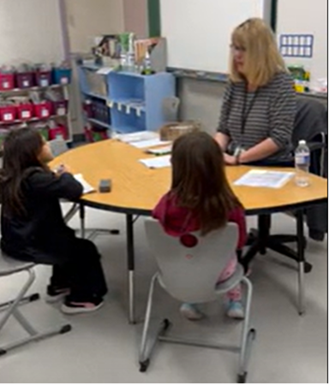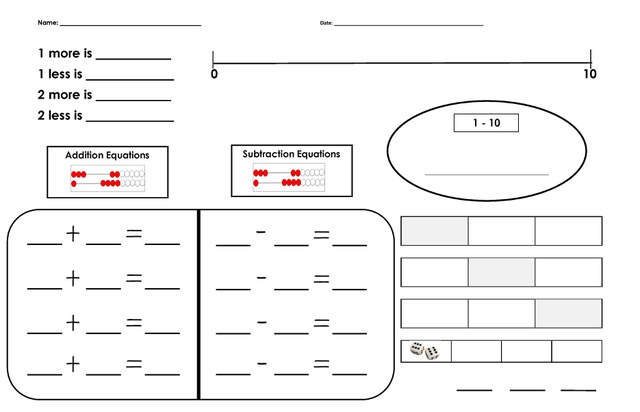Minding the Gap in Mathematics
Using a numeracy screener to support early intervention
IF YOU ARE A PARENT, you likely recall your baby’s wellness visits with the family doctor. During these frequent visits, the focus was on monitoring physical growth and development to identify any issues that might require attention. By plotting children’s individual growth curves and comparing them with standardized charts, physicians can determine whether satisfactory growth is occurring and when intervention is needed.
Just as health practitioners monitor physical growth with charts, educators can monitor learning growth with universal screeners. A universal screener is a short assessment administered to all students in a classroom that tests sub-skills predictive of a more complex skill. In the case of literacy screeners, the sub-skills of phonological awareness and alphabet knowledge are assessed because they are essential for decoding (Biel et al., 2020). Similarly, numeracy screeners include counting, number relations, and basic arithmetic items because they are components of early numeracy (Devlin et al., 2022).
To discover any learning gaps and ascertain progress, universal screeners are often conducted three times over the course of a school year. Initial screener use provides educators with a baseline of students’ abilities that can be used to guide instruction and flag students who may require additional support. A key tracking feature of universal screeners is that target scores are connected with a child’s grade or age. Students who meet target scores are progressing as anticipated, whereas students who are close to or below target scores may be struggling with foundational skills. For students who do not meet target scores, instructional support or intervention is recommended. Tracking students’ progress over time allows teachers, schools, or districts to evaluate the effectiveness of interventions, ultimately determining whether learning gaps have been reduced or closed.
As an educator or school administrator, you are probably aware of the importance of literacy screeners for identifying and supporting children who may be at risk for reading difficulties. You may also be familiar with specific literacy screeners and interventions used in classrooms. Unfortunately, information about numeracy development is not as readily available as it is for literacy, since the field of mathematics cognition research is still fairly new. However, strides in understanding mathematics development and growing interest in supporting early mathematics learning have led to the creation of evidence-based universal numeracy screeners. This article features one such numeracy screener, the Early Math Assessment at School (EMA@School), which is licensed by Alberta Education as the Provincial Numeracy Screening Assessment (PNSA). PNSA data was used by the Grande Prairie Public School Division in Alberta to target students for intervention and assess whether the interventions worked as intended to remediate identified students.
The creation of a numeracy screener
Math learning is cumulative (increasingly complex skills build on one another), so it is important to lay a strong foundation in early mathematics (Sarama & Clements, 2009).
Moreover, when young children begin school, they vary widely in their mathematical understanding and skills, meaning an achievement gap already exists in Kindergarten (Duncan et al., 2007; Jordan et al., 2009). If this math achievement gap is not addressed early, children with less mathematical proficiency will continue to fall behind their peers. Numeracy screeners are a practical tool for identifying students who require extra instruction and intervention to grasp foundational skills.
Data from Alberta suggests that early achievement gaps may have been exacerbated during the COVID-19 pandemic (Child and Youth Well-Being Panel, 2021). In response, Alberta Education has implemented literacy and numeracy screeners for children in Grades 1–3 to help students get back on track. While there is an abundance of evidence-based literacy screeners available for classroom use, comparable numeracy screeners are lacking. For this reason, Alberta Education contacted the Mathematical Cognition Lab (MCL) at Carleton University in the spring of 2021 to discuss the creation of a provincial numeracy screener. Based on their expertise in mathematical development, the MCL constructed a grade-specific numeracy screener for students in each of the primary grades. The screener consists of items assessing number knowledge, number relations, and number operations, because these related subdomains tap into early mathematical knowledge, but they all predict mathematics learning separately (Devlin et al., 2022). Although many tasks are common across grades (with questions reflecting grade-specific knowledge), there are some differences between grades. For students in the younger grades, the screener has a stronger emphasis on number knowledge and number relations (e.g. counting, number naming, comparing numbers), while there is more of a focus on number operations (e.g. arithmetic fluency, principles of addition) for older grades.
Using the numeracy screener to support early intervention
During the 2021/2022 school year, classroom teachers administered the Provincial Numeracy Screening Assessment (PNSA) to over 50,000 primary students. The Grade 1 PNSA involved both one-on-one testing (5 minutes per student) and whole-class testing (15 minutes). For Grades 2–3, the PNSA was implemented in a whole-class setting during a 20- to 30-minute session. Target scores for the PNSA were established, so the tool could be used to identify students who were at risk for low achievement in mathematics. Alberta Education developed intervention lessons that accompanied the PNSA that included: activities for each numeracy sub-skill encompassing concrete-to-representational-to-abstract instructional processes, explicit mathematical vocabulary, and mathematical symbols. The Alberta government provided funding to school divisions to both administer the PNSA and provide needed interventions for students.
In September 2022, the Grande Prairie Public School Division (GPPSD) in Alberta administered the PNSA to students in Grades 2 to 3. Grade 1 students completed the PNSA in January 2023 to allow for some initial mathematics instruction and acclimatization to school prior to screening. To meet the needs of students in the
division, the Numeracy Coordinator designed a comprehensive early numeracy intervention approach, consisting of the following elements:
- Two lead teachers to oversee the intervention program, and 20 education assistants (EAs) to deliver the program in 15 elementary schools
- Intervention designed by the Numeracy Coordinator consisting of scripted and structured mini-lessons based on sub-skills identified in the PNSA for delivery by EAs
- A pull-out small group (two to four students) delivery model used daily for between 20-30 minutes for six-week cycles (see Figure 1)
- Student work captured daily on a math mat during intervention (see Figure 2), with progress being evaluated using an assessment mat (similar to a math mat) and tracked in an Excel spreadsheet for individual students
- Multiple check-in points to oversee student growth (e.g. move on to higher numbers, focus on a new sub-skill, assess whether students are ready for discharge).


Figure 2. A math mat used to capture student learning during early numeracy intervention.
Once students demonstrate strong understanding in most sub-skills, they are discharged from the intervention program. Students who exhibit little to no growth have lessons adapted to meet their needs. In the case where growth is limited even after lesson adaptations, intervention work is used as evidence that students may require formal psychoeducational assessments for learning disabilities.
Overall, the intervention is being well received by the school community. One educational assistant commented on the success of the program: “Because we see the students daily, in small groups, we can target the help they need more individually, giving them the opportunity to ask questions and learn in a small-group setting at their level.” From a classroom perspective, a Grade 2 teacher noted that “the kids come back from intervention with more confidence and willingness to take risks!” To date, intervention tracking data indicates that 431 students (across 15 schools) have received targeted support. Of those students, 330 (77 percent) have advanced to meet target scores in most numeracy sub-skills, earning a discharge from the targeted support. The remaining 101 students, although considered “still at risk” after the six-week cycle, made significant gains, specifically in the sub-skills of number line and computations.
As the GPPSD continues to enhance their early numeracy intervention design, they are focusing on fostering greater collaboration between classroom instruction and the early intervention program to reinforce the learning in both environments. There is no question that numeracy screeners are a powerful tool for helping educators focus on foundational learning needed for future mathematics and life success.
LEARN MORE ABOUT HOW EDCAN SUPPORTS K-12 WORKPLACE WELLBEING
RESOURCES
For more information about numeracy screeners and early numeracy intervention, check out these resources:
Assessment and Instruction for Mathematics (AIM) Collective website: www.aimcollective.ca
Fuchs, L.S., Newman-Gonchar, et al. (2021). Assisting students struggling with mathematics: Intervention in the elementary grades (WWC 2021006). National Center for Education Evaluation and Regional Assistance (NCEE), Institute of Education Sciences, U.S. Department of Education. http://whatworks.ed.gov/
Youmans, A., & Colgan, L. (Eds.). (in press). Beyond 1, 2, 3: Strengthening early math education in Canada. Canadian Scholars Press.
References
Biel, C., Conner, C., et al. (2022). How does the science of reading inform early literacy screening? Virginia State Literacy Association. https://literacy.virginia.edu/sites/g/files/jsddwu1006/files/2022-03/How%20Does%20the%20Science%20of%20Reading%20Inform%20Early%20Literacy%20Screening9888e091cc0c17d238d1c54ce31de7afc4bbc396863e07e1d942a4505c5a17a0.pdf
Child and Youth Well-Being Panel. (2021). Child and youth well-being review: Final report. Government of Alberta. https://open.alberta.ca/publications/child-and-youth-well-being-review-final-report#summary
Devlin, D., Moeller, K., & Sella, F. (2022). The structure of early numeracy: Evidence from multi-factorial models. Trends in Neuroscience and Education, 26. doi:10.1016/j.tine.2022.100171
Duncan, G. J., Dowsett, C. J., et al. (2007). School readiness and later achievement. Developmental Psychology, 43(6), 1428–1446.
Jordan, N. C., Kaplan, et al. (2009). Early mathematics matters: Kindergarten number competence and later mathematics outcomes. Developmental Psychology, 45(3), 850–867. doi:10.1037/a0014939
Sarama, J., & Clements, D. H. (2009). Early childhood mathematics education research. Taylor & Francis.
Photo: iStock
First published in Education Canada, September 2023

